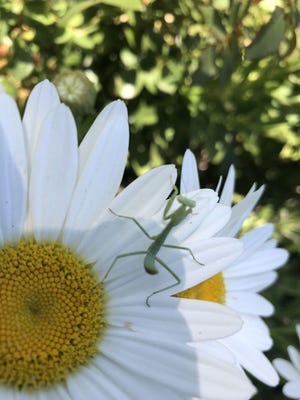What gardeners can do to help insect populations
Recently, as part of the Master Gardener Program, we saw a video of an entomology professor in Florida advocating for better public education on insects.
He also presented some very interesting research he has done on how moths escape predation by bats. Bats and moths are nocturnal and are natural enemies. A butterfly with long swallowtails would sacrifice its tail to the bat to live another day. Another butterfly was making sounds that disturbed bats. It was interesting new research, but the main focus was the loss of insect biodiversity.
There are 5 million species of insects and their biomass is equal to that of all other animals and plants combined. That’s a lot of bugs.
According to a Guardian article, 40% of insect species are in decline and a third are endangered. The rate of extinction is 8 times faster than that of mammals, birds and reptiles which are also in decline.
Total insect biomass is decreasing by 2.5% per year, according to the best available data, suggesting they could be extinct within a century. Butterflies and moths are among the most affected.
For example, the number of widespread butterfly species fell by 58% on cropland in England between 2000 and 2009. Researchers say insects are “essential” for the proper functioning of all ecosystems, as food. for other creatures, pollinators and nutrient recyclers. .

The reason for this decline is the number of humans and our consumption of habitats for our use at the expense of other life forms on the planet. Climate change is also a factor. The conversion of natural spaces for agricultural purposes to feed a growing world population and the widespread use of pesticides are the main cause of the decline of insects.
We are nature’s worst enemy and rarely recognize that we ourselves are part of nature and destroy many of the planet’s ecosystems for our food. Much of our food supply requires pollinators, so we need them if we are to continue to eat melons, chocolate, and many other fruits and vegetables.
So what can we as gardeners do to prevent this decline in insects? Kristin Green in an article in “Fine Gardening” magazine suggests that we do not clean the garden in the fall as was routine, but rather leave the plants in place to provide habitat.
“Traditional methods are changing because our priorities have changed: aesthetics are tied to a higher purpose. Gardens, however carefully designed, maintained and flowering, are also living ecosystems, providing habitat and sustenance for all kinds of wildlife, â€she said. “Many gardeners have become naturalists and stewards, more likely to measure success by the number of pollinator species buzzing around their combinations than by the beauty of those plants together. Many insects, bees, butterflies, moths and spiders overwinter as adults, eggs or cocoon pupae. Some need the insulating shelter of the leaf litter; others attach themselves to stems and twigs.
Amen to that. I am fortunate to have a front yard that is not grass. The previous owner was a master gardener who employed another master gardener with extensive knowledge of native plants and together they converted the lawn to native plants which are excellent habitat for insects. It has become a wilderness area that all the cats in the neighborhood love to explore, apparently in search of prey and sometimes taking a lizard home with them.
In the back garden I have a passion vine which is the habitat of the Fritillary Gulf butterfly caterpillars. Therefore, I have a lot of Gulf Fritillary butterflies visiting the flowers in my garden along with other butterflies such as the Western Swallowtail (Papilio Rutulus), Fiery Skipper (Hylephila phyleus), and Dusky Wing (Erynnis) funeral). You can find a long list of butterflies that can be found in San Joaquin County here: https://bit.ly/3rt0rqQ.
Observing and identifying the insects in your garden keeps the mind active and engaged with the world around us. I have also observed praying mantises in the garden and they often appear unexpectedly on flowers where they are ready to catch pollinating insects. Praying mantises do not choose between which insects are beneficial to us and which we consider to be harmful. Nature has rules that are different from what we humans might want. Good conservation of insects in your garden.
If you have a gardening-related question, you can contact UC’s Master Gardeners at (209) 953-6112. You can find more information on our website: http://sjmastergardeners.ucanr.edu/CONTACT_US/.


Comments are closed.